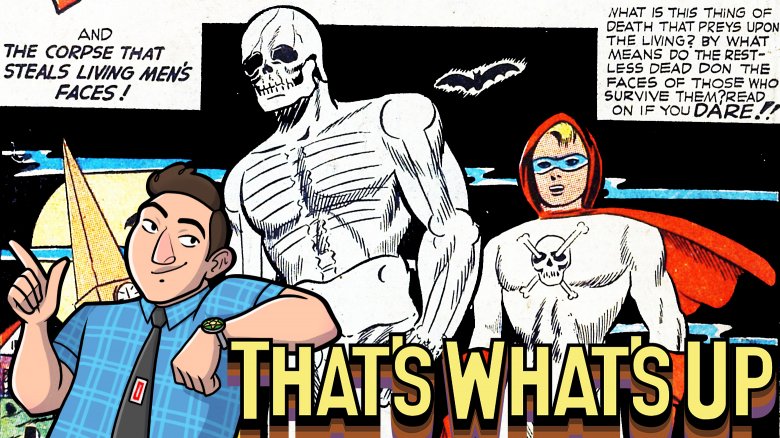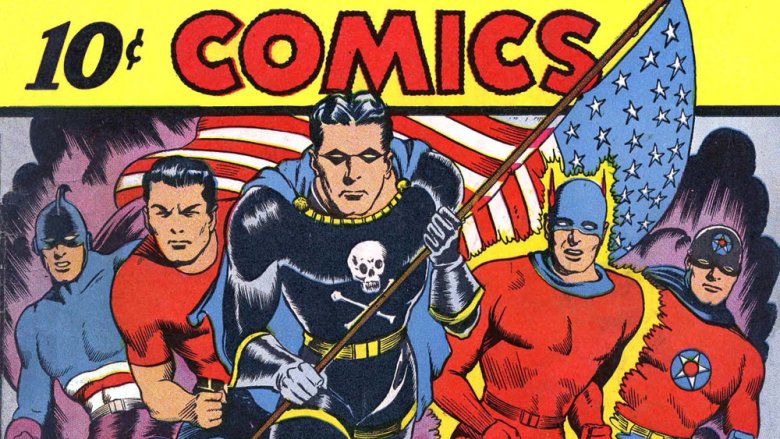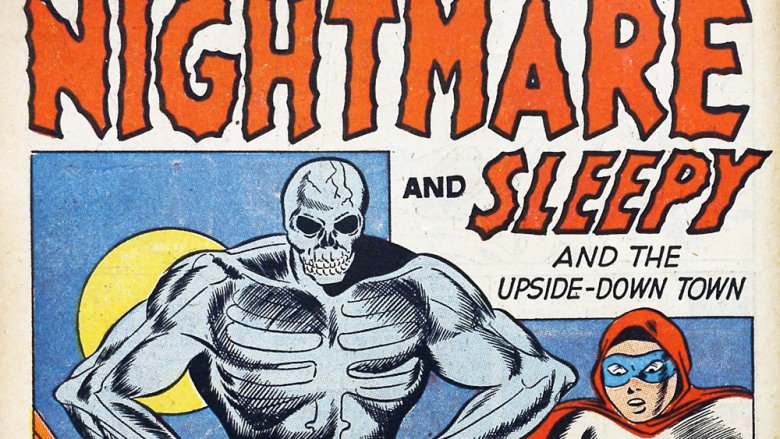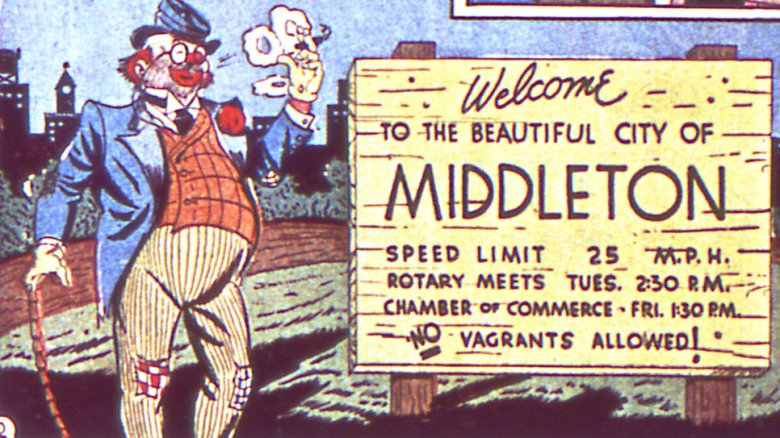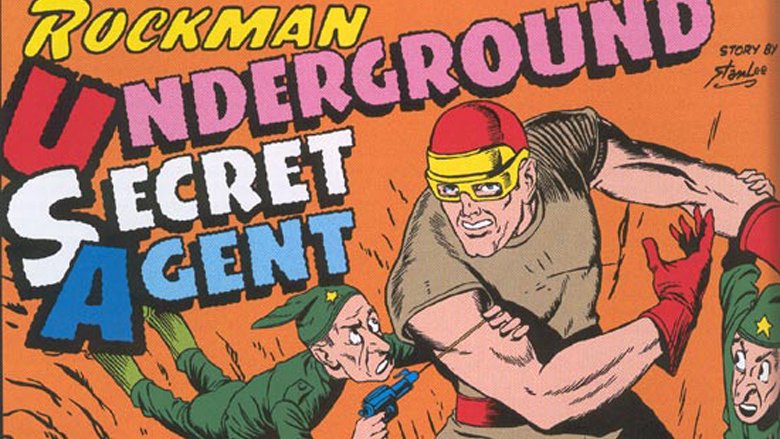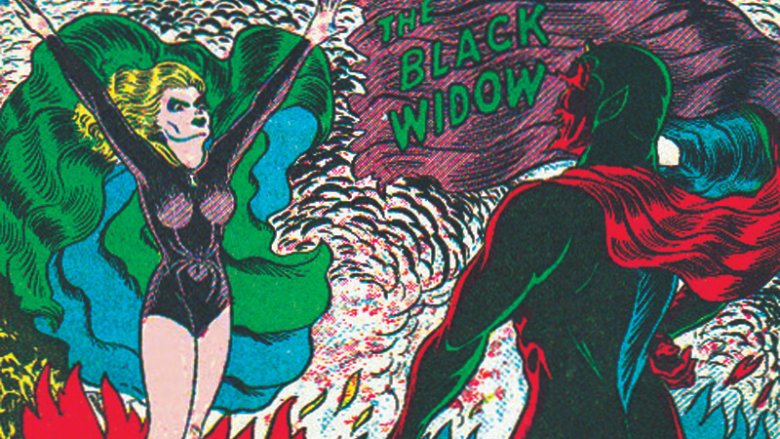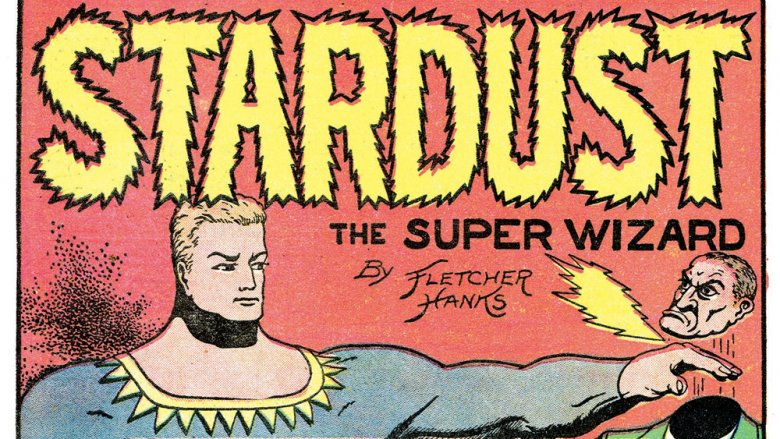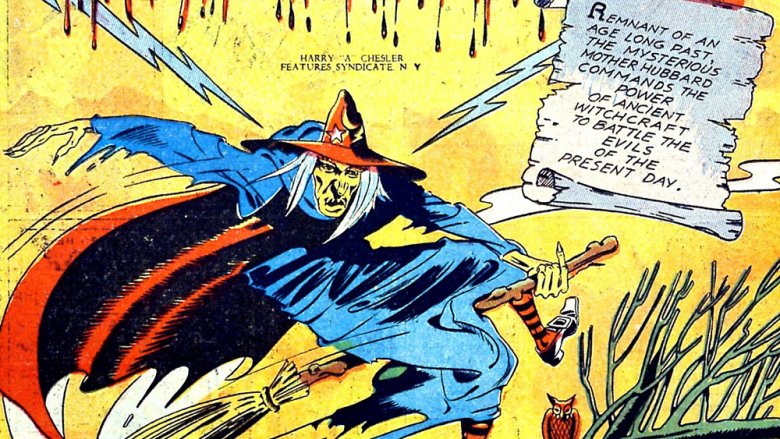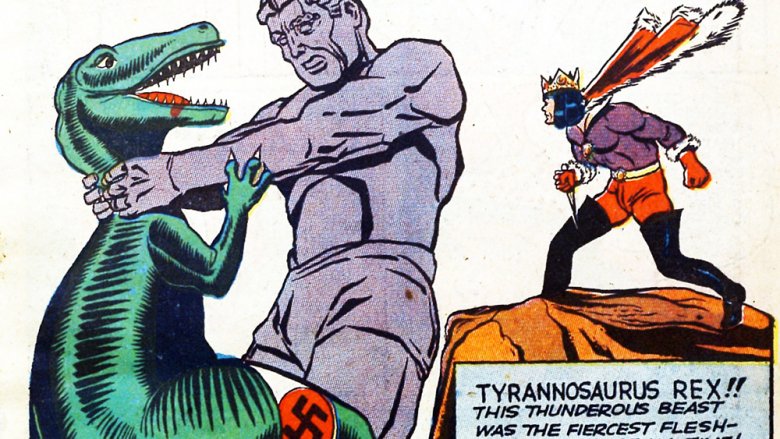That's What's Up: The 7 Best Golden Age Superheroes You've Never Heard Of
Each week, comic book writer Chris Sims answers the burning questions you have about the world of comics and pop culture: what's up with that? If you'd like to ask Chris a question, please send it to @theisb on Twitter with the hashtag #WhatsUpChris, or email it to staff@looper.com with the subject line "That's What's Up."
Q: What's up with Nightmare and Sleepy? — @dfdfleming
In my most recent column, I mentioned that interested readers should ask me about Nightmare and Sleepy sometime, and I'm happy to report that more than one dear reader took the bait. I'm glad they did, too — those are two great characters that you've probably never heard of, and they're not alone. The Golden Age is full of bizarre high concepts and wild characters who only really existed for a year or two before they faded into obscurity, and while they didn't last, they're definitely worth knowing about.
Of course, not all of those characters are as good as a pro wrestler and his teenage "manager" who travel from town to town dressing up in spooky costumes and fighting anti-gravity criminals, but most comics today don't have concepts that good, either. But before we talk about Nightmare and Sleepy, and a handful of other weird old characters that you should get to know, let's talk about why these characters are so weird, and why actually going back to read their stories might not be the best idea.
The Golden Age Boom
Something that I often mention in these columns is that it's virtually impossible to overstate the success that Superman had when Action Comics #1 hit stands in 1938. It wasn't just a massive hit in its own right, introducing the world to a character that would be a household name within months, and it didn't just kick off the superhero genre as a whole. It redefined the comic book as a medium.
Until pretty recently, most histories of comics generally traced the path to what we recognize as the medium we have today as being from political cartoons to stuff like The Yellow Kid — who literally wore his dialogue on on a big yellow shirt rather than having it in word balloons — to Superman's first appearance. If you've ever read Scott McCloud's Understanding Comics, you know that's an incredible oversimplification of how it actually went, but it's not entirely wrong, either. Floyd Gottfredson was doing adventure stories in the Mickey Mouse newspaper strip that have the pacing and action of modern comics as far back as 1929, ten years before Clark Kent would put on his cape, but Superman was the first capital-letter Comic Book Character to achieve that level of fame and fortune in his native medium, and he's the one that a tidal wave of imitators were trying to copy when they started appearing in books like Top Notch Comics, Fight Comics, and an obscure mystery title called Detective Comics.
By and large, and I say this as someone who's read quite a few of them, the Golden Age stories that were actually consistently good were the ones that you've heard of. Characters like Superman, Wonder Woman, Batman, Captain America, and the original Captain Marvel — known today as Shazam, whose stories were so popular that he was appearing in about ten comics a month and outselling Superman by a margin that can only be described as massive — stuck around for a good reason. The thing is, they only represent a fraction of what was actually happening on newsstands around the country back in that late '30s, early '40s boom period.
There was an explosion of new titles trying to serve a public that just could not get enough of these new "super-hero" characters, and what makes them really fascinating is that they're all trying to figure out how to replicate Jerry Siegel and Joe Shuster's success while also having no idea how to tell stories in this brand-new genre that would turn out to have some pretty strict conventions. They weren't exactly breaking the rules, but only because the rules of superhero comics didn't actually exist yet.
And that's how we got characters like Nightmare and Sleepy.
Nightmare and Sleepy
Nightmare and Sleepy originally appeared in 1943's Clue Comics #1, alongside characters like Zippo, a crime fighter who sped around with one big wheel on each foot, and Microface, whose face was actually a pretty normal size. As you might guess from the Hero-and-Sidekick names, they were basically Clue's knockoff of Batman and Robin. They've got all the familiar elements — the scary costumes, the secret identities, the relationship between an older hero and a younger sidekick who's not his son — but they're all put together in a way that's... well, if not "wrong," certainly pretty dang bizarre.
Rather than being a billionaire playboy and his youthful ward, Bob White was a traveling pro wrestler, and Terry Wake his youthful "manager." As for why a wrestler needs a 12-year-old to be his manager, that's explained in the first issue when Bob says that he defers all of his work-related concerns to his young friend so that he won't get taken advantage of by crooked wrestling promoters. To be fair, that's a pretty accurate portrayal of the carnival wrestling business of the '40s as I understand it, but on the other hand, it's a pretty dire state of affairs for this guy if he thinks Vince McMahon's grandfather is going to have a harder time stiffing him on his payday if he lets an 8th grader handle his business.
With that kind of setup, you might think that "The Nightmare" is Bob's gimmick, and that he wears his full-body glow-in-the-dark skeleton costume for both in-ring action and for his crimefighting, like El Santo. That is not the case. Not only does Bob White wrestle under his real (and distressingly generic) name, he also does so while wearing a full suit and tie, as do all of his opponents. Alan Mandel's not a bad artist, particularly by Golden Age standards, but he has very little concept of what pro wrestling is, even for 1943.
Fortunately, he makes up for that with all the other stuff. Once Bob is done dealing with his suited grappler competition, he always winds up stumbling on some truly buck wild criminal activity. Once, it was a baseball team made up entirely of diamond thieves, and once it was a town where criminals were faking anti-gravity by tying people to the floor with invisible ropes, but if you're going to read one, I would direct you to "The Corpse That Stole Living Men's Faces," which is some straight-up Scooby Doo stuff but with people's faces falling off and men being cast into "the Death Pit." It rules.
The Vagabond
The trope of the secret identity had been around in pop culture since Baroness Orczy laid down the foundation for superheroes with The Scarlet Pimpernel, but the creators of the Golden Age seemed to have a lot of difficulty figuring out how to make it compelling. For another truly weird twist on it that goes well beyond a wrestler in a business suit, check out the Vagabond, who made his debut in Marvel's U.S.A. Comics #2.
The core idea here was pretty simple: FBI agent Pat Murphy needed to go undercover to root out some mobsters in the town of Middleton, but his face was "too well known in this town." Clearly, he needed a disguise that would allow him to mingle with the local hoodlums. Here's where it gets weird, though: while the text insists that he disguises himself as "the world's most famous hobo," what he actually does is disguise himself as a full-on Barnum-and-Bailey-ass circus clown version of a hobo that the story calls "The Vagabond," but who according to the narration is "better known to himself" (?!) "as Chauncey Throttlebottom III."
As The Vagabond/Chauncey, Pat strolls around Middleton wearing a comically padded torso under an oversized patchwork suit, with a gigantic red smile painted on his face, dropping five-dollar words and asking for jobs at places that happen to be run by crooks and fifth-columnists. In his first appearance, his place of employment is a waterfront tavern where mobsters are luring cops to the basement so they can drop them into the ocean and force them to climb up a ladder with "razor-sharp rungs," which will cut off their fingers if they try to escape. Chauncey, who is offered a job by the bad guys despite being a literal clown, beats them all up and everything works out okay.
Rockman, the Underground Secret Agent
Another amazing (or at least amazingly bizarre) character from the pages of U.S.A. Comics is Rockman, the Underground Secret Agent. It should be noted that while he does in fact live underground, he is by no means a secret agent, but, y'know, there's a war on and we gotta get that patriotic content in there somehow.
Created by Basil Wolverton (but with a handful of stories scripted by a rookie writer under the pen name "Stan Lee"), Rockman was the ruler of Abysmia, an underground kingdom beneath the United States that was founded when "our ancestors, the first white inhabitants of this continent" (yikes) sought shelter from the Ice Age. With Nazis threatening the world, Rockman decided to help his surface-dwelling brothers battle against the scourge of tyranny, which, thanks to Lee, mostly involved adventures that were just Flash Gordon in a cave instead of space. He fought saboteurs in his first appearance, but by U.S.A. #3, he was rescuing a princess from a race of tiny underground "pixies" who look like garden gnomes and had been seduced by the lure of communism.
Unlike most of the characters I'm writing about today, Rockman actually did make a brief comeback in the pages of The Twelve a few years back. Unfortunately, that book decided that Rockman should be a coal miner who became delusional after surviving a cave-in, presumably because the idea of a superhero monarch of an underground monster kingdom was just too silly for the modern Marvel Universe, which literally began with Fantastic Four #1, a comic about a supervillain monarch of an underground monster kingdom.
The Black Widow
There's one last Golden Age Marvel character I want to talk about, because in a list of great ideas from the Golden Age that more people should know about, I would be absolutely remiss if I didn't mention the Black Widow. No, not Natasha Romanova from the Avengers, the other one. The first costumed, superpowered female hero in comics. Claire Voyant: an assassin who works directly for Satan.
As her name implies, Claire was a psychic who was indirectly killed by Satan in a sort of Rube Goldberg machine of curses. Once she was dead, Satan personally carted her off to Hell, where he resurrected her with the power of dark magic, and personally charged her with going back to Earth and killing the wicked before they could repent so that he could claim their souls and torture them forever. Why Satan, who can clearly drop curses on someone and orchestrate complicated death chains to get what he wants, needs a human agent in a superhero costume to go do his bidding is never explained, but that hardly matters. This concept rules harder than literally any other adventure hero Marvel was publishing in 1940.
Unfortunately, Claire only lasted until 1943, and never got a revival once superheroes were back in vogue. It turned out that the whole "our sexy lady superhero works for Satan and murders people who are beyond the reach of the law to send them straight to Hell" is exactly the kind of story that the Comics Code was meant to put the kibosh on when it was introduced in the '50s. She's still canonically a part of the Marvel Universe, though, and I feel like that puts her about two days away from a comeback at any given time.
Stardust the Super Wizard
By all accounts, including those of his son, Fletcher Hanks was not a good person. If, however, you can separate the art from the artist, his work is fascinating, and probably the single best example of what comics were like when people had no idea what the rules should be.
He created a handful of weird characters, including a jungle adventure heroine named Fantomah and a two-fisted lumberjack named Red McClane, but Stardust the Super Wizard — "whose vast knowledge of interplanetary science has made him the most remarkable man that ever lived" — is by far the most notable. There's a direct line from Superman straight to Stardust, too. If Superman showed us a person who had powers far beyond those of mortal men, which gave him the power to do anything, then Stardust asked the next somewhat logical question. If you can do anything, why would you limit yourself to things that made sense?
Thus, Stardust's adventures in "racket-busting" generally involved him dealing with crooks by transforming them into human-headed rats, or freezing their bodies while leaving them conscious of every passing second so they could contemplate their crimes for eternity, or just cold throwing them into space. The most bonkers example, though, is when he shrinks a man's body until it is absorbed by his head, then throws the still-living head into space, where it is caught by a headless monster whose neck is actually its mouth, who puts the head on his neck and then slowly digests it over the course of years. When people talk about Superman being weird in the '50s, that's the sort of thing I point to.
Stardust, along with Hanks' other creations, has experienced a relative resurgence in popularity lately thanks to a pair of books put out by Paul Karasik that collect his work: I Shall Destroy All The Civilized Planets and You Shall Die By Your Own Evil Creation, which have in turn been collected in a hardcover omnibus with the equally awesome title Turn Loose Our Death Rays And Kill Them All! If you actually go and read anything I've written about today, those should probably be the ones.
Mother Hubbard
The most direct influence on the early superheroes came, of course, from pulp magazines and sci-fi. Batman was a riff on the Shadow, with his first appearance coming in a beat-for-beat recreation of a story called "Partners of Peril," right down to Bob Kane using some suspiciously similar art. Superman definitely put things together in a new way, but was clearly at least partially inspired by Doc Savage and Philip Wylie's Gladiator. In Scoop Comics #1, however, Bill Madden looked to a slightly different bit of source material for his new creation: Mother Hubbard.
Madden's Mother Hubbard was an aged crone with a blood-dripping logo who "commands the power of ancient witchcraft to battle the evils of the present day," and unlike her nursery rhyme counterpart, her cupboard was fully stocked with Madman's Blood and Bat's Claws. In her first outing, she took on a Nazi spy who was selected by Hitler for his "inhumanity and cruelty," who attempted to get some secrets out of a scientist by threatening to burn said scientist's son with a swastika-shaped branding iron. Mother Hubbard paralyzed him and burned him and his compatriots to death in a "roaring inferno," because she is not here to play.
Things get even weirder a few issues later, where Mother Hubbard moves on to fighting ogres who eat babies (on panel!) and tears out their eyes, only to have the ogres hire a gnome to get them new eyes, which he does by prying them out of children's heads with a crowbar while they sleep. It is fully bananas horror movie stuff, and it's great.
The Boy King
I've gone through a handful of characters here, and there are plenty more out there who are every bit as weird as these. That said, I don't want to lose sight of my original purpose here, which was to get you to go back and check out Nightmare and Sleepy. If you need a little extra incentive to do so, however, here's two pieces of information. First, every issue of Clue Comics is in the public domain, meaning that it's pretty easy and perfectly legal to find online. Second, they're not the only great characters in that comic. There's also... the Boy King.
The Boy King is a king who is also a boy. That's pretty much it for him, aside from the fact that he dresses like Prince Valiant and was inspired to fight evil when his country, "Swisslakia," was overrun by Nazis. What really makes him great, though, is that once he's deposed, he goes to a nearby cave and resurrects Siwsslakia's secret weapon, a silent 50-foot stone giant who obeys his every command and goes into action to end the scourge of tyranny by wrestling Hitler's 50-foot robot Tyrannosaurus.
Listen, y'all. Comic books are actually pretty good.
Each week, comic book writer Chris Sims answers the burning questions you have about the world of comics and pop culture: what's up with that? If you'd like to ask Chris a question, please send it to @theisb on Twitter with the hashtag #WhatsUpChris, or email it to staff@looper.com with the subject line "That's What's Up."
